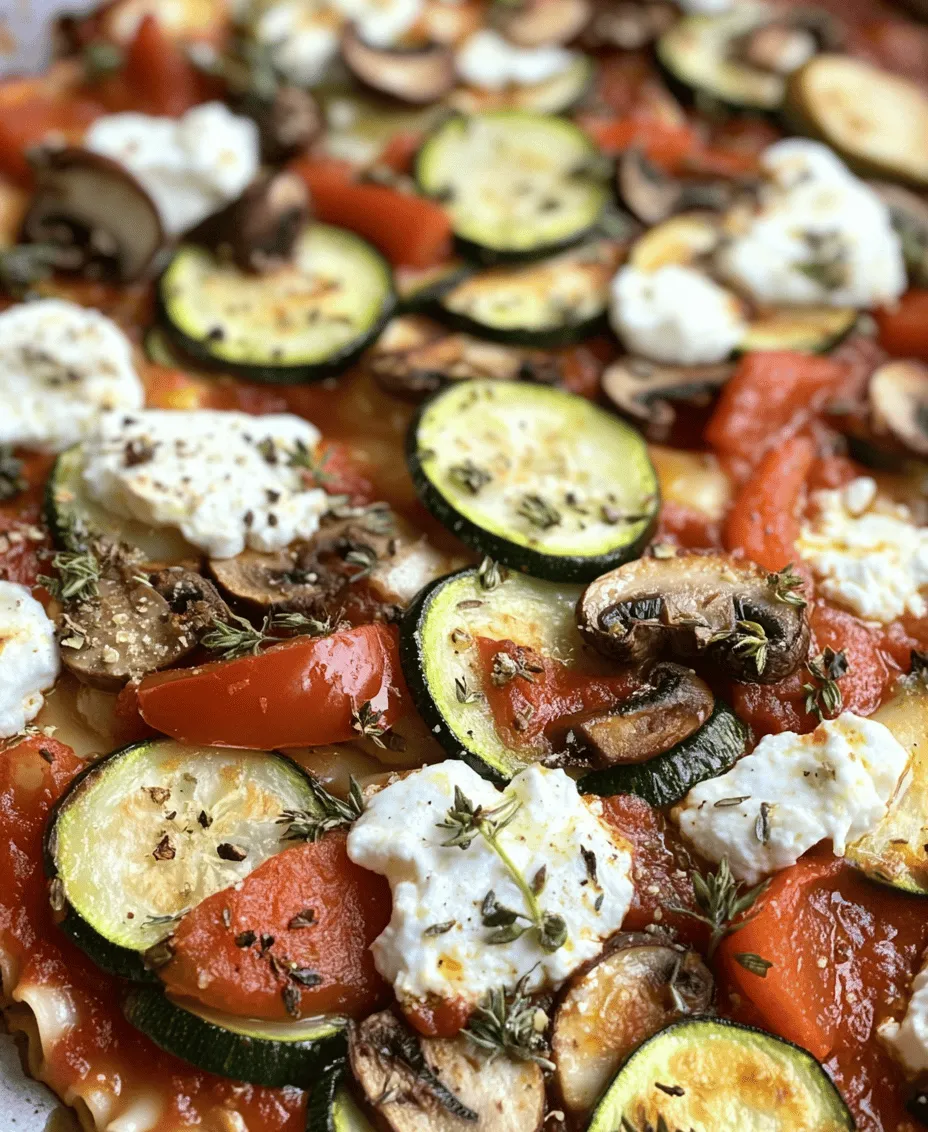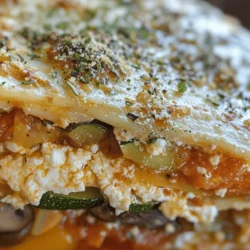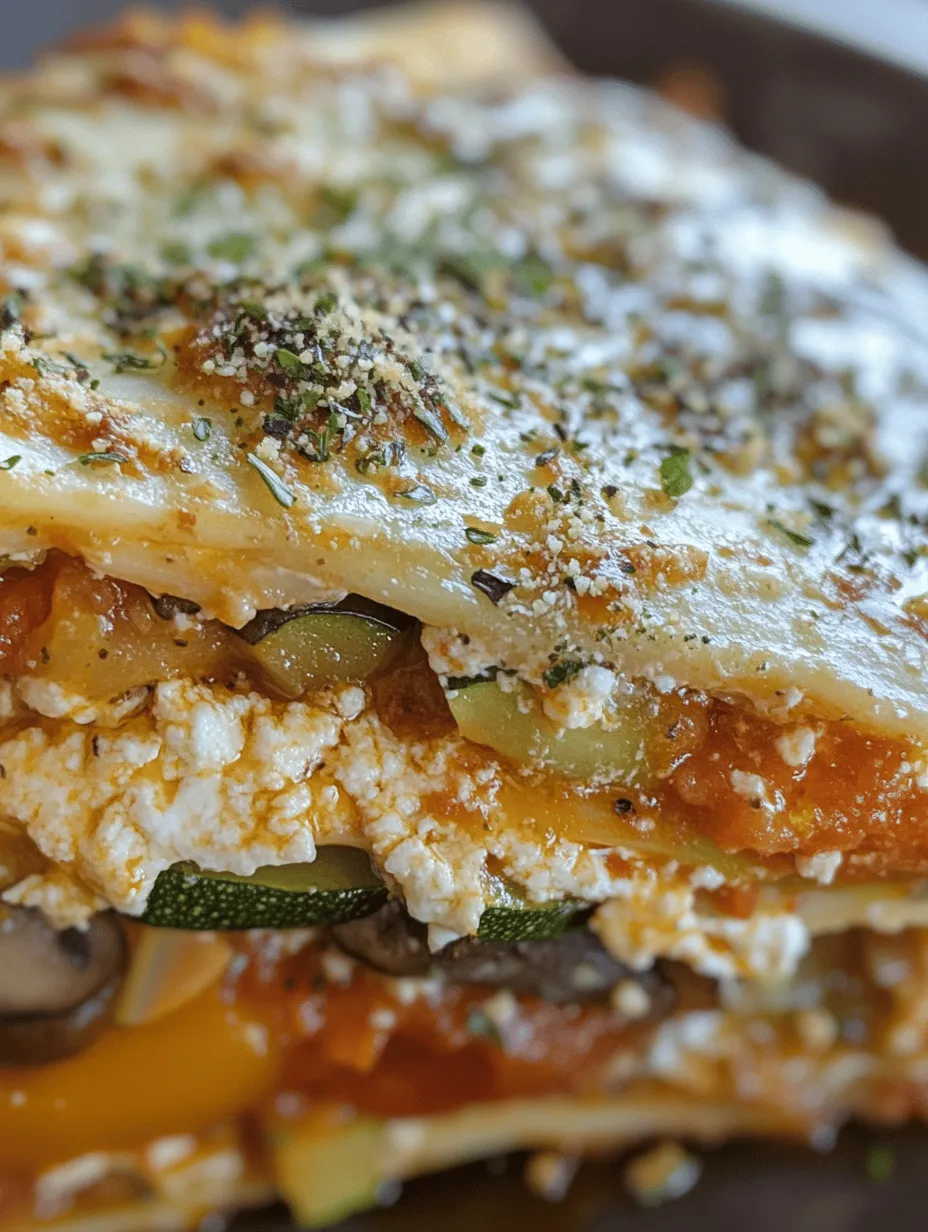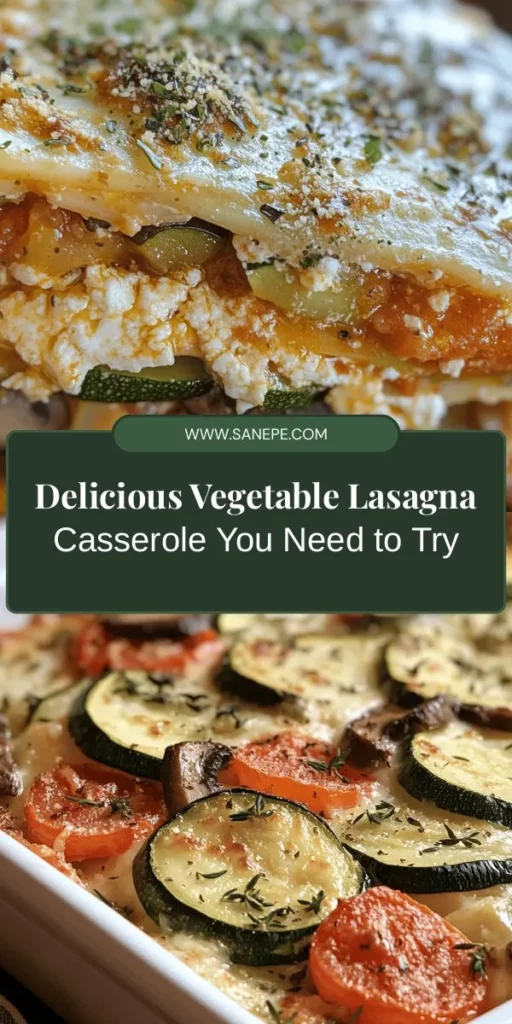Introduction
In the world of culinary creations, few dishes offer the satisfying comfort and robust flavors that a vegetable lasagna casserole can provide. This layered delight is not only a feast for the eyes but also a nourishing meal that caters to the growing demand for plant-based options. With a perfect balance of fresh vegetables, creamy ricotta, and tangy marinara sauce, this casserole combines texture and flavor in every bite.
In recent years, the popularity of plant-based dishes has surged, with more people seeking out meals that are both delicious and health-conscious. This vegetable lasagna casserole is an excellent choice for anyone looking to incorporate more vegetables into their diet or for those who want a hearty meal without the meat. Whether you are a seasoned vegetarian, a health-conscious omnivore, or simply someone who enjoys a good comfort meal, this recipe is sure to satisfy your cravings while providing essential nutrients.
The beauty of this vegetable lasagna lies in its layers. Each component contributes to a harmonious blend of flavors and textures, making it an ideal dish for gatherings, family dinners, or meal prep for the week ahead. The vibrant colors of the vegetables, the creamy ricotta, and the gooey cheese on top come together to create a dish that is as pleasing to the palate as it is to the eye. So, let’s dive into the ingredients that make this casserole a standout dish and explore the preparation steps to bring this layered delight to your table.
Understanding the Ingredients
Before we embark on the cooking journey, it is essential to understand the key components of our vegetable lasagna casserole. Each ingredient plays a crucial role in not only enhancing the flavor but also contributing to the overall nutritional profile of the dish.
Lasagna Noodles
The foundation of any lasagna is, of course, the noodles. When it comes to choosing lasagna noodles, there are several options available, each with its unique characteristics. Traditional lasagna noodles are made from refined wheat flour, which provides a chewy texture. However, for health-conscious cooks, whole wheat or gluten-free alternatives offer a more nutritious option. Whole wheat lasagna noodles add fiber and nutrients, while gluten-free options, such as brown rice or lentil lasagna noodles, cater to those with gluten sensitivities. Regardless of the choice, the noodles should be cooked to al dente to maintain their structure during baking, ensuring a perfect balance of texture amidst the creamy layers.
Ricotta Cheese
Ricotta cheese is a staple in Italian cooking, known for its creamy texture and mild flavor. In our vegetable lasagna casserole, ricotta serves multiple purposes. It contributes a luscious creaminess that balances the textures of the other ingredients. Additionally, ricotta is a good source of protein and calcium, making it a nutritious addition to the dish. To elevate the flavor of the ricotta, we can mix it with herbs and spices, creating a delectable filling that complements the vegetables beautifully.
Vegetables
The stars of this vegetable lasagna casserole are undoubtedly the vegetables. In this recipe, we will be using zucchini, bell peppers, spinach, and mushrooms. Each of these vegetables not only adds vibrant colors to the dish but also brings a wealth of health benefits.
– Zucchini is low in calories and high in antioxidants, making it an excellent choice for weight management and overall health.
– Bell peppers are rich in vitamins A and C, promoting healthy skin and boosting the immune system.
– Spinach is a nutrient powerhouse, loaded with iron, calcium, and vitamins K and E, supporting overall health and wellness.
– Mushrooms add a savory umami flavor and are a great source of B vitamins, selenium, and antioxidants.
The combination of these vegetables creates a medley of textures and flavors, ensuring that each bite of the lasagna is both satisfying and nutritious.
Herbs and Spices
No Italian dish is complete without the addition of herbs and spices. In our vegetable lasagna casserole, oregano and basil take center stage. These herbs not only enhance the flavor profile of the dish but also provide various health benefits.
– Oregano is known for its antibacterial properties and is a rich source of antioxidants, which help combat oxidative stress in the body.
– Basil contributes a sweet and slightly peppery flavor that brightens the dish while also offering anti-inflammatory properties.
Incorporating fresh or dried herbs into the ricotta mixture and layering them throughout the casserole will infuse each bite with aromatic flavors.
Marinara Sauce
Marinara sauce is the lifeblood of any lasagna, providing moisture and depth of flavor to the dish. Made from ripe tomatoes, garlic, and herbs, marinara sauce brings a tangy sweetness that complements the richness of the cheese and the freshness of the vegetables. Using a high-quality marinara sauce or even making your own allows for greater control over the ingredients and flavor. It’s also an excellent way to sneak in extra vegetables or spices if desired. A well-seasoned marinara sauce will elevate the entire casserole and create a rich, hearty base for the layers.
Cheese Toppings
To crown our vegetable lasagna casserole, we cannot forget the cheese toppings. Mozzarella and Parmesan are the classic choices, each contributing its unique characteristics.
– Mozzarella is known for its gooey, melty texture, which creates that desirable cheese pull when served. It adds richness without overpowering the other flavors.
– Parmesan, on the other hand, offers a sharp, nutty flavor that enhances the overall taste of the casserole. Sprinkling Parmesan on top of the mozzarella creates a delightful golden crust that adds both flavor and visual appeal to the dish.
Together, these cheeses meld beautifully, creating a creamy, cheesy topping that is simply irresistible.
Preparation Steps
Now that we understand the ingredients that make this vegetable lasagna casserole a healthy and delicious meal, let’s delve into the preparation steps that will bring this dish to life.
Preheat the Oven
The first step in preparing our vegetable lasagna casserole is to preheat the oven. Setting the correct temperature is crucial for ensuring that the casserole cooks evenly and thoroughly. Preheating the oven to 375°F (190°C) allows for the perfect baking environment, allowing the layers to meld together beautifully while achieving a golden, bubbly top.
Cooking the Noodles
Next, we need to prepare the lasagna noodles. Bring a large pot of salted water to a rolling boil and add the noodles. If using traditional or whole wheat lasagna noodles, cook them according to the package instructions until they reach an al dente texture. This is important because the noodles will continue to cook in the oven, and we want to prevent them from becoming overly soft and mushy. For gluten-free noodles, be sure to follow the specific cooking time indicated on the package, as these can vary.
Once cooked, drain the noodles and lay them flat on a clean kitchen towel to prevent them from sticking together while you prepare the other components of the dish.
Sautéing the Vegetables
While the noodles are cooking, it’s time to sauté the vegetables. Start by heating a tablespoon of olive oil in a large skillet over medium heat. Add chopped onions (if desired) and garlic, allowing them to become fragrant and translucent. Then, add the diced zucchini, bell peppers, and mushrooms to the skillet.
Sauté the vegetables for about 5-7 minutes, or until they are tender and slightly caramelized. The goal here is to enhance their flavors and reduce excess moisture, which will prevent the casserole from becoming watery. Finally, add the spinach and cook just until wilted. Season the sautéed vegetables with salt, pepper, and half of the oregano and basil, allowing their natural flavors to shine through.
Creating the Ricotta Mixture
In a separate bowl, combine the ricotta cheese with the remaining herbs, salt, and pepper to taste. For an added depth of flavor, consider mixing in a splash of lemon juice or a pinch of nutmeg. This ricotta mixture will serve as the creamy layer in our lasagna, providing a delightful contrast to the vegetables and marinara sauce. Mix until the ingredients are well combined and the mixture achieves a smooth consistency.
With all components prepared, we are now ready to assemble our vegetable lasagna casserole, bringing together the layers of flavor and nutrition that make this dish so special.
Stay tuned for the next part, where we will explore the assembly process in detail and discover how to create the perfect layered delight.

Layered Delight: Vegetable Lasagna Casserole
Layering Techniques
The beauty of a vegetable lasagna casserole lies in its layers, where each ingredient contributes to a symphony of flavors and textures. Proper layering is crucial not just for aesthetics but also for ensuring even cooking and optimal flavor distribution throughout the dish.
1. Start with Sauce: Begin your layering with a thin layer of marinara or your chosen sauce at the bottom of the baking dish. This not only prevents the noodles from sticking but also adds moisture to the bottom layer, ensuring they cook properly.
2. Noodle Placement: Place the first layer of noodles neatly over the sauce. If you’re using traditional lasagna noodles, ensure they slightly overlap to create a seamless layer. If using no-boil noodles, ensure they fit snugly as they will expand while cooking.
3. Add Vegetables and Cheese: Follow the noodles with a generous portion of your vegetable mixture. Use a variety of vegetables—such as zucchini, bell peppers, and spinach—ensuring an even distribution. Top this with a mixture of ricotta cheese, mozzarella, and a sprinkle of Parmesan. This layering technique allows the flavors to meld while ensuring every bite is bursting with different tastes.
4. Repeat Layers: Continue layering in this order: sauce, noodles, vegetables, and cheese. Aim for at least three layers for a casserole that’s rich and satisfying. Your final layer should conclude with sauce and a generous topping of cheese for that golden, bubbling finish.
Final Assembly
Final assembly is where the casserole truly comes together, and careful attention to detail will yield a beautifully layered dish.
1. Complementary Layers: Each layer should complement the others in flavor and texture. For instance, if you’ve used a robust marinara sauce, consider adding a hint of Italian seasoning to your ricotta mix for added depth.
2. Distributing Ingredients: As you layer, be diligent about evenly distributing the vegetables and cheese. This ensures that every slice of the casserole contains a balanced portion of all components, providing a delightful experience with each forkful.
Baking the Casserole
Baking is a crucial step that transforms your assembled ingredients into a cohesive and utterly delicious casserole.
1. Covering with Foil: Before placing your casserole in the oven, cover it with aluminum foil. This step is essential for preventing over-browning and promoting even cooking. The foil traps moisture, ensuring the noodles cook through without drying out.
2. Baking Time: Preheat your oven to 375°F (190°C) and bake the casserole covered for about 30 minutes. After this initial period, remove the foil and bake for an additional 15-20 minutes. You’ll know the casserole is done when the cheese is bubbling and golden brown, and the sauce is visibly bubbling around the edges.
Cooling and Serving
Once your casserole is cooked to perfection, patience is key before diving in.
1. Cooling Time: Allow the vegetable lasagna casserole to cool for at least 15-20 minutes before slicing. This cooling time helps the layers set, making it easier to serve neat slices rather than a messy heap.
2. Serving Suggestions: This casserole pairs beautifully with a fresh green salad or some garlic bread. For a gourmet touch, sprinkle fresh basil or parsley on top before serving, adding both flavor and a pop of color.
Nutritional Information
This vegetable lasagna casserole is not only delicious but also packed with nutritional benefits.
– Per Serving: Approximately 350 calories, 12g protein, 15g fat, 42g carbohydrates, and 5g fiber.
– Health Benefits: The assortment of vegetables contributes vitamins A and C, while the whole grain noodles provide fiber that aids digestion. The use of low-fat cheese options can also reduce calorie intake without sacrificing flavor.
Variations and Customizations
The layered nature of this casserole makes it highly adaptable to various dietary preferences.
1. Gluten-Free Options: For those following a gluten-free diet, substitute traditional lasagna noodles with gluten-free alternatives made from rice or chickpeas. Ensure your sauce is gluten-free as well, which many store-bought options are today.
2. Vegan Adaptations: To create a vegan-friendly version, replace ricotta cheese with blended tofu mixed with nutritional yeast and herbs for a creamy texture. Use vegan mozzarella for the topping to maintain that gooey, delicious finish.
3. Additional Vegetables: Feel free to get creative with the vegetable content. Seasonal vegetables like asparagus in the spring or butternut squash in the fall can elevate your dish. You can also sneak in some kale or mushrooms for added nutrition and flavor.
Conclusion
The Vegetable Lasagna Casserole is a delightful dish that embodies comfort food while catering to a variety of dietary preferences. Its layered structure not only enhances the flavor but also offers a visually appealing centerpiece for any meal. This recipe encapsulates the joy of cooking, allowing you to explore different flavors and textures that can be customized to your liking.
Whether you’re serving it at a family gathering, a potluck, or just enjoying a cozy night in, this casserole is sure to satisfy. Embrace the joys of cooking by trying this layered delight in your kitchen, and don’t forget to share the love by passing the recipe along to friends and family. Happy cooking!


